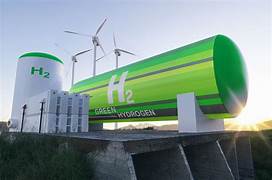India is looking for fresh means to fuel its future with Bio-CNG and green hydrogen. On April 3, 2025, a report shed light on how these fuels can contribute to sustainability and reduce emissions. They are the cornerstones of India’s net-zero vision. Below is how they’re making a difference and what to expect.
The Power of Bio-CNG
Bio-CNG, or biogas compressed, is manufactured from organic waste such as animal dung and food waste. It is a cleaner fuel than fossil fuels. India can produce 62 million tonnes of Bio-CNG annually, according to a 2023 Lukmaan IAS report. The government aims to commission 5,000 CBG units by 2025, with a projected production of 15 million tonnes. “Five per cent mixing of biogas with natural gas will save LNG import USD 1.17 billion,” a Drishti IAS report said. Blending begins on voluntary basis until FY25 and becomes mandatory from FY26 onwards.”.
Green Hydrogen’s Potential
Green hydrogen is made using renewable energy to split water. It’s a zero-emission fuel for industries, transport, and power. India’s National Green Hydrogen Mission targets 5 million tonnes of production by 2030. The government has set aside Rs 496 crore for mobility pilot projects and Rs 115 crore for shipping pilots through 2025-26, per mnre.gov.in. “To make India the Global Hub for production, usage and export of Green Hydrogen,” the mission aims to boost clean energy and cut imports.
Key Highlights
- Bio-CNG Output: 62 million tonnes possible yearly; 5,000 plants by 2025 for 15 million tonnes.
- Savings: 5% biogas blending saves $1.17 billion in LNG imports.
- Green Hydrogen Goal: 5 million tonnes by 2030.
- Funding: Rs 496 crore for mobility, Rs 115 crore for shipping pilots through 2025-26.
Why It Matters
These fuels tackle big challenges. Bio-CNG cuts waste and emissions while powering vehicles and industries. Green hydrogen can decarbonize hard-to-clean sectors like steel and shipping. All of them are in line with India’s 2070 net-zero target. They also reduce reliance on imported fuels, making energy more secure. Amul Dairy’s Bio-CNG plant, the first in India’s food processing sector, leads the way on how waste can be turned into energy.
Challenges to Overcome
It’s hard to scale. Bio-CNG needs more crop and better waste collection. Green hydrogen has high manufacturing cost and technology issues. Hydrogen needs to get 30% cheaper by 2030 if it is to stay in the running, a 2023 IEA report said. Infrastructure—the pipes, and storage need capital too. It needs publicity because both fuels need increased consumption.
The Big Picture
India’s energy mix is evolving. Solar and wind are complemented by green hydrogen and Bio-CNG, resulting in a balance clean energy system. Blending mandates and government funding reflect commitment. A 2023 Lukmaan IAS report recommends raising awareness for the promotion of consumption of Bio-CNG. As India develops, these fuels can fuel a sustainable future.
Bio-CNG and green hydrogen are paving the way for India. With ambitious targets and actual success, they’re assisting in reducing emissions and creating energy self-sufficiency for the nation. The journey has only just begun, but the potential is enormous.

